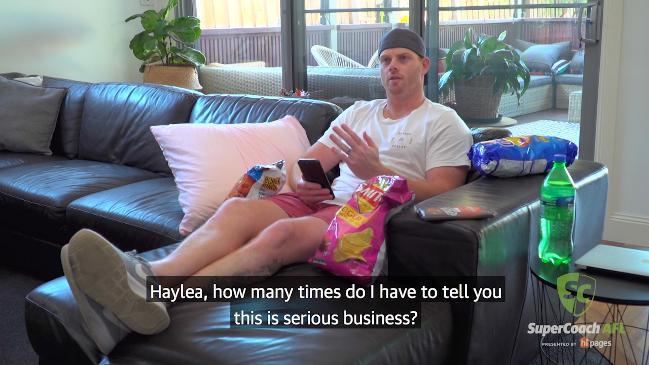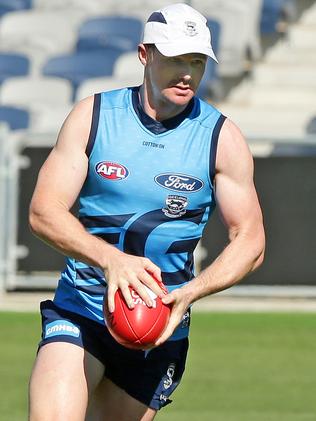Why having a loophole could be key to SuperCoach success in 2018
COULD an ex-soccer player who’s never played an AFL game lead us to SuperCoach success? We look at why picking a non-playing “loophole” is crucial and how best to exploit it.

COULD an ex-soccer player yet to play an AFL game become key to your AFL SuperCoach plans?
While most of our team will be fluid in the lead up to the season, one position that we can lock in early is our third ruck spot (R3).
MUST READ: EVERY SUPERCOACH SCORE FROM JLT SERIES
ROOKIE BIBLE: THE SUPERCOACH CASH COWS TO KNOW
BURN MEN: WHO’S ON YOUR NEVER AGAIN LIST?
UNIQUE PODS: SUPERCOACH GUNS TO SET YOU APART
At TooSerious.net and now here at SuperCoach HQ, we like to analyse the AFL fixture each season to determine the best option for us to use for loopholes.
Read on to find out some of the best options for 2018 and why R3 is the best.


WHAT IS A LOOPHOLE?
Prior to the rolling lockout being introduced to SuperCoach in 2013, ‘loopholes’, as they became widely known in fantasy football land, were only able to be used in Round 1 and split rounds, but now can be taken advantage of in every round of each season.
It is basically a way of hedging your bets, by choosing players playing early in the round as your vice-captain (VC) and emergencies. If your vice-captain scores well, move your non-playing player on field and set as your captain to ensure the high scoring vice-captain becomes the default captain and their score is doubled for that round.
If an emergency has a good game and you can bring a non-playing player into your starting 22 on the same line of your high scoring emergency, the emergency’s score will count.
It’s a tactic that can have a huge benefit for your team.
You can lock in a superstar as your VC in case they have an unexpected poor game, or you can get creative and make a speculative VC choice. Either way, if you get it right, it’s a simple move that can give you a leg up over many others.
Sometimes it is difficult to know what VC score is good enough to keep. The general view seems to be to try your luck with a playing captain if your VC scores any less than 130 but this rule doesn’t always stack up.
Lot’s can go wrong, especially with injuries, and sometimes it’s better to take the points you have from your VC and lock it in.


HOW TO PLAY IT BEST
Clearly, the crucial part to this plan is having a non-playing player you can use each week.
With cash generation being a hugely important aspect to do well at SuperCoach, we really shouldn’t waste positions with players who aren’t getting games and making money for our teams.
However, the benefits justify putting one of the 30 positions aside for a non-player.
Last season, for many, this was Luke Strnadica ($123,900 ruck) from Fremantle who was a dual position player (DPP) in 2017, and R3 in my team.
It’s even better if they are DPP because then they can be available for multiple lines, often referred to as a ‘floating doughnut’.
As for starting Round 1 with a non-player, you should use your ruck bench.
That said, if you’re selecting a ruck with an injury concern such as Nic Natainui ($465,900), you might want to play it safe, forgo the loopholes and select someone like Sydney’s Darcy Cameron ($123,900) or the Bulldogs’ Tim English ($134,700) who are probably the most likely rookie-priced rucks to play games this season.
Be careful though, if you go with this strategy, don’t then start with a non-player on a different line.


When you play the loophole, it means you can’t actually have an emergency for that line available in case a player is a late withdrawal (remember the rule that if you have two emergencies on one line, if one is needed for your team the player with the lower score is activated).
Hence, there is more risk using up your emergency on other lines where there are more players with a chance to be a late withdrawal.
Added to this, rookies on other lines generally score better and accumulate cash for your team quicker, meaning you should make the most of those spots with players actually playing.
Now the question is, do we start with a DPP?
Usually we have been lucky to have a host of strong DPP ruck/forward options, such as Toby Nankervis ($488,300 ruck) and Patrick Ryder ($566,500 ruck) last season. For this reason, it has usually been beneficial for your designated loophole non-player to be a DPP as well, however it isn’t as much of a priority this season.
It’s difficult to find a DPP ruck/forward who is capable of holding their own in a SuperCoach forward line this season.
Perhaps Mason Cox ($304,800 ruck/fwd) could turn out to be a strong mid-priced option? He certainly turned it on with a whopping score of 145 in the second JLT game last weekend.

TOP LOOPHOLE OPTIONS
When deciding which player to bring in as a non-player, the most important consideration is when they play their games.
If you were to have a player who plays most of their games on a Friday night, then you wouldn’t even be able to use them as a captain in those games because they would be locked before you could see your VC’s score.
It’s best to look for players playing most of their games late in the round to open up the most options for you week to week.
This season there are six DPP ruck/forward players priced under $135,000, and four rucks at the minimum price of $102,400. The first and easiest thing to do is to rule out five of these players due to their teams playing too many games on Thursday and Friday nights.
The remaining players up for consideration are North Melbourne’s Tom Jeffries ($102,400 ruck), West Coast’s Tony Olango ($102,400 ruck), Port Adelaide’s Sam Hayes ($117,300 ruck/fwd), GWS’s Matthew Flynn ($123,900 ruck/fwd) and Collingwood’s Max Lynch ($123,900 ruck/fwd).
Keep in mind that when a player’s team is on a bye, they don’t lock until the end of the round and can therefore be used for a loophole at any stage during that round.
Everyone will therefore have a multitude of options for loopholes during the three main multi-bye rounds and I have excluded those three rounds from this analysis.
Round 23 is also excluded due to that round’s fixture not being set until later in the year.


The fixtures of the remaining DPP options are all very similar. Hayes was a big shout due to Port Adelaide not having any games on a Thursday or Friday night but Collingwood’s Max Lynch looks to be the best of the five DPP options with three games that are the final game of the round and a further four games on Sundays.
Out of the DPP options, he also had the least amount of games that took place prior to a Saturday night, which is what gave him the advantage.
Moreover, Lynch was a soccer goalkeeper in his junior days before he decided to try AFL footy for the first time at the age of 15 at Jindera in NSW.
However the standout of all options is clear and it just happens to be another ex-soccer player, West Coast rookie, Tony Olango.
The Eagles’ big man grew up playing soccer in the Northern Territory and was once invited to Scotland for a three-month trial with soccer giants Rangers as a teenager.
Olango was drafted by West Coast in last year’s rookie draft after showing a lot of promise in two seasons with the NT Thunder in the NEAFL.
Coming in at $21,500 cheaper than Lynch, it’s money well saved because Olango and West Coast have a whopping six games that are the last game of the round and six more Sunday games, that’s 12 Sunday games in total, from 19 rounds.
Added to this, West Coast’s only game on a Thursday or Friday night comes during the multi-bye rounds, making Olango almost a perfect option for this loophole role on your team.
Yes, it’s a negative that he can only be used in one position, but the lack of genuine ruck/forward options for your forward line makes this a small issue.
Olango may have a bright AFL future ahead and may end up a popular SuperCoach choice in years to come due to his playing abilities, but this season he’ll be developing most likely in the WAFL and can still be a popular SuperCoach selection.
When picking your team, scroll right down to the last spot in the list of rucks and lock in Tony Olango as your R3 option. Then each week, enjoy the luxury of seeing your vice-captain’s score before deciding whether to double it or try a different player.
Make the right decisions and this could be the edge you need for SuperCoach 2018.
Originally published as Why having a loophole could be key to SuperCoach success in 2018




